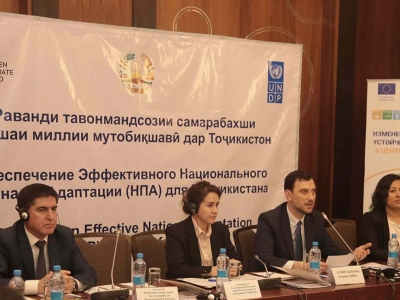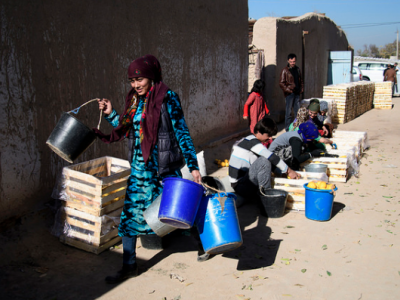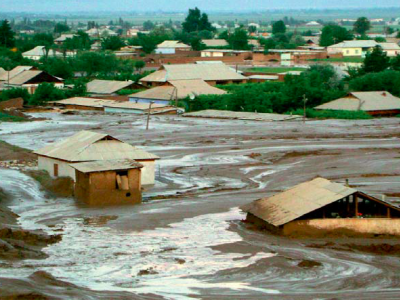Supporting Tajikistan to advance their NAP process
Project Overview
Sep 2015
Tajikistan submits their Intend Nationally Determined Contribution (INDC) to the Paris Agreement
Dec 2016
Readiness proposal submitted to the GCF to strengthen the capacity of the National Designated Authority for strategic engagement with the GCF
Mar 2017
Tajikistan ratifies the Paris Agreement and submits their First Nationally Determined Contribution (NDC)
Jun 2017
NAP-GSP undertakes a mission to Tajikistan to take stock of adaptation policies and suggest next steps for the country’s NAP process
Jul 2017
Development of a Stocktaking Report and a preliminary roadmap for advancing the NAP process in Tajikistan
Aug 2018
Submission of the Readiness proposal to the GCF, requesting support to enable an effective NAP process for Tajikistan
Country background, Sustainable Development Goals and Paris Agreement
Tajikistan is the smallest country in Central Asia and has mountains covering around 93 percent of its territory. About 73 percent of its 8.92 million residents live in rural areas with more than half (51.2 percent) employed in the agricultural sector, constituting the largest source of income for the poorest rural households and accounting for 20.38 percent of the overall GDP. Almost one-third of the population lives below the poverty line, which adds significantly to the climate risk vulnerability of a country that is already identified as the most vulnerable among all European and Central Asian countries.
Between 1940 and 2000 Tajikistan’s climate has increased by more than 1°C in some places, which is causing detrimental damage to the country’s glaciers. It is projected that the total glacial area will decline by 15-20 percent within the next 30-40 years. Glacial runoff enhances the risk of drought, which will degrade aquatic ecosystems, deplete water resources, and increase the risk of mudflows and floods. In a country that is heavily reliant on a rain-fed agricultural industry – 85 percent of arable land is irrigated – the combined effects of less water and more prolonged droughts are very problematic, and in some regions crop yields are expected to fall by up to 30 percent. This will contribute to a decline in food security, as well as the productivity of major export commodities like cotton.
Until recently, Tajikistan’s climate change policy focused on mitigation, stemming from the 2003 National Action Plan for Climate Change Mitigation. However, the government is in the process of finalising its National Climate Change Adaptation Strategy (NCCAS) that aims to provide a guiding framework on how to integrate climate change considerations into other national development plans, a process that will be paramount to achieving the Paris Agreement and the Sustainable Development Goals. Further information on Tajikistan’s climate change strategy can be found in the three National Communications to the UNFCCC in 2002, 2008 and 2014, which outline the impacts the country is expected to experience up to 2100. Similarly, Tajikistan’s Nationally Determined Contribution (NDC) is of crucial importance and refers explicitly to agriculture, irrigation and water systems, power supply, transport, housing, and industrial development as a focus for adaptation measures.
How has the NAP-GSP supported to date?
|
Undertook a stocktaking mission to identify next steps in the NAP process
|
Between 8–9 June 2017, the NAP-GSP undertook a preliminary mission to identify Tajikistan’s strategic priorities regarding the NAP process. Through a stakeholder roundtable, qualitative interviews and extensive desk research, an assessment of relevant initiatives on climate mainstreaming as well as the institutional frameworks and capacities relevant to the NAP process was conducted.
|
|
Developed a roadmap for Tajikistan’s NAP process
|
Informed by the mission, a Stocktaking Report including a roadmap for the NAP process was prepared. It took into consideration a number of institutional weaknesses that need addressing, such as: (1) insufficient coordination and cooperation amongst key ministries and agencies; (2) no smooth process to collect and update climate risk information, needed to prioritise interventions; and (3) a lack of awareness on what needs to be done to integrate adaptation considerations into all policies and plans, as well as a lack of financial resources to execute such a process.
|
|
Helped build capacity and facilitated access to additional climate finance
|
Tajikistan submitted their Readiness and Preparatory Support Proposal to the Green Climate Fund (GCF) in August 2016. The GCF subsequently approved the Readiness proposal, making funding available to Tajikistan for “Strengthening Capacity of National Designated Authority for Strategic Engagement with the Green Proposal Climate Fund.”
|

 National Adaptation Plan for climate change kicks off in Tajikistan
National Adaptation Plan for climate change kicks off in Tajikistan  Statement by Pratibha Mehta at GCF Dialogue
Statement by Pratibha Mehta at GCF Dialogue  Supporting NAP for DRR in Tajikistan
Supporting NAP for DRR in Tajikistan  Supporting NAP for DRR in Tajikistan
Supporting NAP for DRR in Tajikistan 